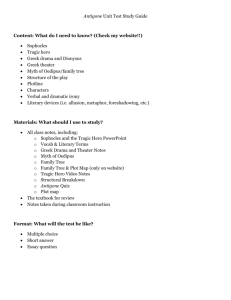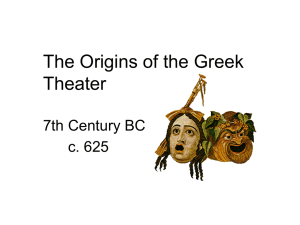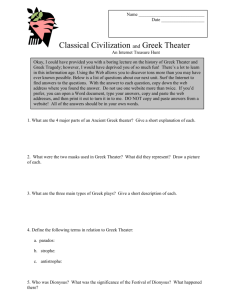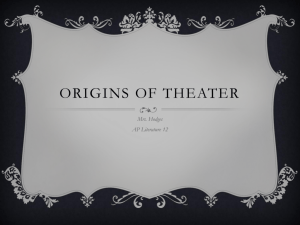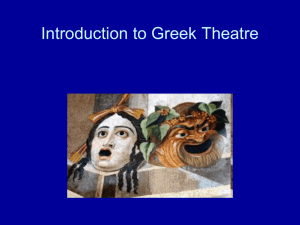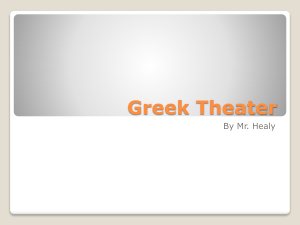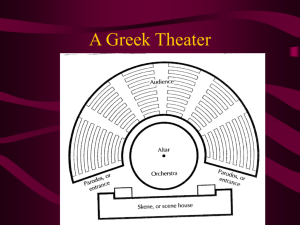GREEK DRAMA
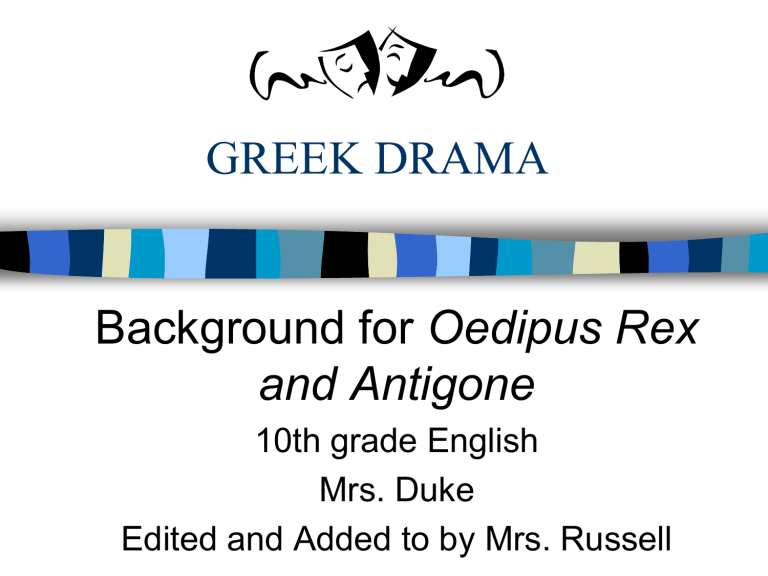
GREEK DRAMA
Background for Oedipus Rex and Antigone
10th grade English
Mrs. Duke
Edited and Added to by Mrs. Russell
How did drama begin?
Traveling groups sang about myths and legends.
Playwrights decided to write down the stories in a form that could be acted out.
Playwright acts out the play by himself
1st actor- Thespis 534 B.C.
Aeschylus (525-456 B.C.), added the second actor, so there was interaction.
Sophocles added a third actor.
Sophocles (496-
406 B.C.)
Abolished the
“trilogic form”
Each play could be a complete entity in itself
Responsible for the invention of scene painting and
“ periaktoi ”- a threesided revolving apparatus painted with scenery and used at each side of the stage.
Sophocles
Wrote 100-120 plays; seven have survived in their entirety
Wrote the “Theben
Plays”
Oedipus the King
(Oedipus Rex)
Oedipus at Colonus
Antigone
“DIONYSIA”
Religious event held in the spring of each year
Festival honoring the Greek god,
Dionysus
Play competitions held at the Theater of
Dionysus at Athens (TDA)
Audience would cast stone ballots to vote for the winner
Play competitions
3 playwrights chosen to perform three tragedies and one satire each
Satire --humorous play about the three tragedies just presented
– A SATYR PLAY IS A FARCICAL, OFTEN BAWDY PARODY OF THE
GODS AND THEIR MYTHS.
Lasted three days, sunrise to sunset
Each playwright presented on one day
At the end of the third day, a laurel wreath and a cash award was given to the winning playwright.
Winners
Aeschylus and Sophocles won the most competitions. Sophocles won at least 20 times.
Euripides (480-406 B.C.), while winning less competitions, foreshadowed the ultimate form of drama as we know it -employing a far more naturalistic or human approach in his works, in contrast to the remote scale and formalized conventions used by his contemporaries.
Comedies
Aristophanes (448-380 B.C.) and Menander
(342-292 B.C.) were the greatest comic writers.
A separate competition for comedy which, while also dedicated to Dionysus, took place at the smaller winter festival, rather than the major spring festival at which the tragedies were presented.
These were dependent on topical humor and satire for much of their content, and have not survived the ages as well as tragedies -which deal with more universal themes.
One of two gods of the earth along with
Demeter
God of poetry, drama, the song, and wine
Son of Zeus and
Semele (or
Persephone)
He was believed to have died every winter and revived every spring.
Worshipped by a religious cult
Believed to be able to take the form of animals to be sacrificed
Worshipped during the festival and given credit for being able to have drama
Structure of the Greek theater--
THEATER
Outdoor stadium--3,000 spectators – the largest ultimately held twenty thousand people
Theatron -“the seeing place”-- was audience seating
Orchestra --circular area for the chorus
Skene building --building used for dressing, entering and exiting the performance area
Theatron
Located on a sloped surface, usually a hillside
Half or semi-circle
Contained wooden or stone benches built into the hillside
Patrons looked down onto the performance area
Segregated seating
Patrons were from ALL classes
Orchestra
A flat, circular area where the chorus stood
Separated from the audience by a stone retaining wall
Contained a Thymele in the center of the circle (an altar to Dionysus)
Chorus proceeded to the orchestra by way of the parados
Skene
Flat-roofed scene building
Temporary construction of wood, later became permanent
Located across the rear of the orchestra circle
Used as a dressing area for actors
The Greek Theater
The Greek Theater
skene paragos thymele theatron orchestra
The Greek Theater
Theater of Dionysus in Athens, Greece
The Greek Theater
The Greek Theater
The Greek Theater
The Greek Theater
The Greek Theater
Theater--Machinery used
Trap door on the skene--divinities could appear on the roof
Mechane --a crane supported by a large stone that allowed characters to “fly”
Ekkyklema -”thing which rolls out”-
-low rolling platform used to display dead bodies or to wheel out characters who were ill
Who acted out the plays?
“ Hypocrits ”=Actors, role players
Actor and playwright were originally the same
Never have more than three hypocrits
All male performers--played female roles also
Costumes
Long flowing robes, often with vertical stripes
Oversized and well-padded
High boots with raised soles or stilts
Colors were symbolic
Masks
Made of linen, wood, or cork
“Larger than life”
Identified age, gender, emotion
Exaggerated features-large eyes, open mouth
Amplified sound
Masks
Made of linen, wood, or cork
“Larger than life”
Identified age, gender, emotion
Exaggerated features-large eyes, open mouth
Amplified sound
Masks
Made of linen, wood, or cork
“Larger than life”
Identified age, gender, emotion
Exaggerated features-large eyes, open mouth
Amplified sound
Masks
Made of linen, wood, or cork
“Larger than life”
Identified age, gender, emotion
Exaggerated features-large eyes, open mouth
Amplified sound
Chorus
Contained 15 men who chanted and danced
Choragos --the spokesman or leader of the chorus
Commented on the action of the play and interpreted its meaning for the audience in chants and odes
Function of the Chorus
Sets the overall mood and expresses theme
Adds beauty (theatrical effectiveness) through song and expressive dance
Gives background information
Divides action and offers reflections on events
Questions, advises, expresses opinion
(choragos)
Chorus
Location of the chorus
I.
Structure of a Greek Tragedy
II.
III.
IV.
V.
VI.
Prologue – exposition – provides background information to set up the conflict
Parados – entrance of the chorus with the opening choral ode
Episodes – scenes
Stasima – choral odes
Paean – song to Dionysus
Exodus – action after the last stasimon, final scene
Odes
Poems chanted that were used to conclude each scene
Musical accompaniment-flute, lyre, percussion
Also called stasima
(stasimon)
Epode -final stanza
Paean
Song/Poem of thanksgiving to
Dionysus
Given just before the exodus (final scene)
Conventions of Greek Drama
Convention = agreement between artist and audience
MESSENGER
Tells news happenings away from the scene
Reports acts of violence not allowed to be seen onstage
Conventions of Greek Drama
“STAGE
DECENCIES”
No violent action in front of the audience
Scenes of horror occur off-stage and are reported to audience
Dialogue or messenger report
Limitations of the Theater
Continuous presence of the chorus “on-stage”
No intermissions, continuous flow of action and choral odes
No lighting
no curtains
Aristotle's Six Elements of Drama
1. Plot (the incidents or story line)
2. Character (physical, social, psychological, moral--people represented in the play)
3. Thought/Theme (insights into humanity and life
4. Music (all sound)
5. Spectacle (scenery and other visual elements)
6. Diction/language (the dialogue and poetry)
Conventions of Greek Drama
UNITIES – a way of providing a central focus to a play. Aristotle believed perfect tragedies had:
Unity of Action – simple plot with no mixture of tragedy and comedy
Unity of Time – single day
Unity of Place – one location of scenes
For More About Greek Drama:
The Glory that was Greece
Greek Drama and Culture
Greek Drama
Aristotle
Ancient Theatre
Greek Theatre
Dr. J's Illustrated Greek Theater
